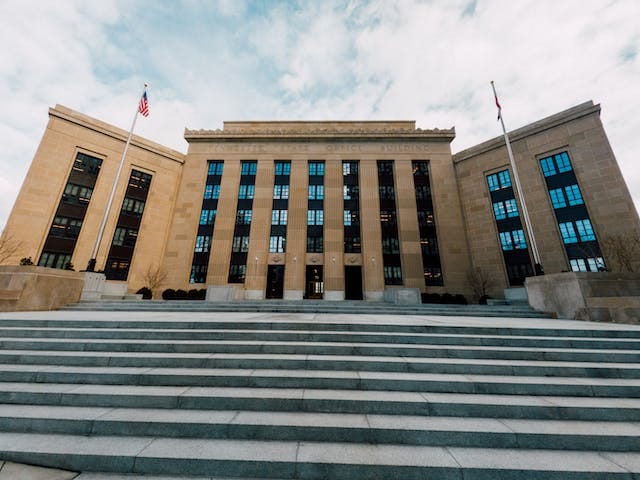The Federal Reserve's Impact on Price Stability: A Deep Dive into its Branches and Banking System
Explore the profound influence of the Federal Reserve on price stability through an in-depth analysis of its branches and banking system. Delve into this comprehensive guide to understand the mechanisms and strategies shaping economic stability and monetary policy

Introduction to the Federal Reserve
The Federal Reserve, also known as the Fed, is the central banking system of the United States. Established in 1913, its primary objective is to maintain a stable and healthy economy. The Fed plays a crucial role in regulating monetary policy, supervising banks, and promoting financial stability. It is an independent entity, meaning it operates free from political influence.
Role and responsibilities of the Federal Reserve

The Federal Reserve's main responsibility is to ensure price stability and full employment. To achieve this, it has three primary tools at its disposal: open market operations, the discount rate, and reserve requirements. Open market operations involve buying and selling government securities to control the money supply. The discount rate is the interest rate at which banks borrow from the Fed, and reserve requirements determine the amount of funds banks must hold in reserve.
In addition to monetary policy, the Fed also supervises and regulates banks to ensure the safety and soundness of the financial system. It conducts regular examinations of banks, enforces consumer protection laws, and provides oversight to promote fair and efficient markets. Furthermore, the Fed plays a critical role in promoting financial stability by monitoring and addressing risks within the banking system.
The Federal Reserve's impact on price stability
Price stability is a crucial aspect of a healthy economy. The Federal Reserve aims to keep inflation at a moderate level to avoid any detrimental effects on the purchasing power of consumers and businesses. By utilizing its monetary policy tools, the Fed can influence interest rates, which in turn affects borrowing costs and spending patterns. When inflationary pressures arise, the Fed may raise interest rates to cool down the economy and prevent prices from escalating too rapidly. Conversely, when the economy faces deflationary risks, the Fed may lower interest rates to encourage borrowing and spending.
Maintaining price stability is essential for businesses and individuals to make informed economic decisions. When prices remain relatively stable, businesses can plan for the future, invest, and hire with confidence. It also provides a stable environment for consumers, ensuring that their savings retain their value over time.
Understanding the branches of the Federal Reserve
The Federal Reserve operates through a network of twelve regional banks located across the country. These regional banks, along with the Board of Governors in Washington, D.C., make up the Federal Reserve System. Each regional bank serves a specific district and plays a vital role in implementing monetary policy, supervising banks, and providing financial services to depository institutions.
The regional banks act as a bridge between the Federal Reserve and the local communities they serve. They gather economic data, provide insights on regional economic conditions, and contribute to the formulation of monetary policy. Additionally, the regional banks offer a range of financial services to depository institutions, such as processing checks, distributing currency and coin, and providing electronic payment services.
The Federal Reserve's banking system
The Federal Reserve's banking system consists of both member and non-member banks. Member banks are commercial banks that have chosen to join the Federal Reserve System voluntarily. They enjoy certain benefits, such as access to the Fed's discount window and the ability to influence the selection of directors at their respective regional banks. Non-member banks, on the other hand, are not part of the Federal Reserve System but are still subject to its regulations and oversight.
The Federal Reserve also acts as a lender of last resort to banks in times of financial stress. It provides short-term loans to banks through its discount window to ensure the stability of the banking system. This function is crucial in maintaining confidence in the financial system during times of economic uncertainty.
Exploring the functions of the Federal Reserve banks

The Federal Reserve banks perform various functions to support the smooth functioning of the financial system. One of their primary responsibilities is to supervise and regulate banks within their respective districts. This includes conducting examinations, reviewing bank activities, and enforcing compliance with applicable laws and regulations. The regional banks also play a role in fostering financial stability by monitoring and addressing risks in the banking system.
Additionally, the Federal Reserve banks facilitate the clearing and settlement of payments between banks. They operate the automated clearinghouse system, which allows for the efficient transfer of funds between financial institutions. The regional banks also play a critical role in distributing new currency and coin to meet the demands of businesses and consumers.
Job opportunities at the Federal Reserve
The Federal Reserve offers a wide range of job opportunities for individuals interested in finance, economics, and public service. From economists and research analysts to bank examiners and financial policy advisors, there are various roles within the Federal Reserve System. These positions provide an opportunity to contribute to the nation's economic stability and growth.
To explore job opportunities at the Federal Reserve, interested individuals can visit the official website of the Board of Governors or the regional banks. These websites provide information on available positions, qualifications, and application processes. Additionally, networking events and career fairs can also provide valuable opportunities to connect with Federal Reserve representatives and learn more about potential career paths.
Resources for learning more about the Federal Reserve
For those interested in delving deeper into the workings of the Federal Reserve and the banking system, there are numerous resources available. The Federal Reserve's website offers a wealth of information, including publications, research papers, and educational materials. It provides a comprehensive overview of the Fed's roles and responsibilities, monetary policy, and regulatory functions.
In addition to the official resources, there are several books that provide in-depth insights into the Federal Reserve and the banking system. Some notable titles include "The Federal Reserve System: Purposes and Functions," "The Courage to Act: A Memoir of a Crisis and its Aftermath" by Ben Bernanke, and "The Alchemists: Three Central Bankers and a World on Fire" by Neil Irwin. These books offer historical context, analysis, and personal accounts of key events and decisions in the Federal Reserve's history.
Conclusion
The Federal Reserve plays a critical role in maintaining price stability and promoting a healthy economy. Through its monetary policy tools, regional banks, and regulatory functions, the Fed ensures that inflation remains in check and the financial system operates smoothly. Understanding the Federal Reserve's branches and banking system provides valuable insights into its inner workings and the impact it has on the economy.
Whether you're interested in pursuing a career at the Federal Reserve or simply seeking a deeper understanding of its role, there are numerous resources available to expand your knowledge. From official websites and publications to books written by experts in the field, these resources offer a comprehensive look at the Federal Reserve and its impact on price stability. By exploring these resources, you can gain a greater appreciation for the importance of the Federal Reserve in shaping the nation's economic landscape.
CTA: If you're interested in learning more about the Federal Reserve and its impact on the economy, visit the official website of the Board of Governors or explore recommended books on the subject.




